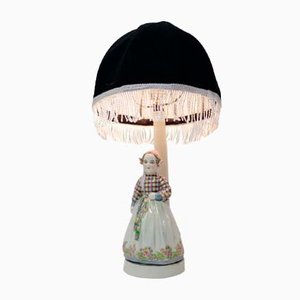
Austrian sculptor and ceramist Josef Lorenzl (1892-1950) is remembered for his delicate and whimsical bronze and ivory sculptures and figurines, which are considered exemplars of Austrian Art Deco sculpture .
Born in 1892 in Vienna, Lorenzl apprenticed at a foundry at the military storage complex Vienna Arsenal, where he became skilled in bronze casting. Rather than working in traditional metalwork industries such as construction, Lorenzl turned his hand to sculpture. His work celebrated the female form, depicting graceful dancers. Like his contemporaries Ferdinand Preiss (1882-1943) and Demetre Chiparus (1886-1947), Lorenzl’s figurines were either made in bronze or chryselephantine, which is a combination of various materials in sculpture including, ivory, bronze, gold, and silver.
Early in his career, Lorenzl began working for the Austrian ceramics company Goldscheider, alongside Stephan Dakon (1904-1992). By the 1930s, both artists were the principal designers at Goldscheider.
Notable designs for Goldscheider include Captured Bird (c. 1922)—often referred to as Butterfly Wings—modeled after the 1920s actress and dancer Niddy Impekoven; the Egyptian Dancer (1922), also known as Odalisque, which represents a temple dancer from Verdi's Aida; and the Arabian Dancer (c. 1925). From the mid-1920s, Lorenzl began to focus more on nude sculptures, a change from his earlier designs which generally featured clothed women, in dancers’ dress, for which he is best known.
Over the course of his career, Lorenzl also worked for the Viennese companies Keramos, Wiener Kunstkeramik, and Porzellanmanufaktur AG, as well as the German firms Hertwig and Cortendorf.
Lorenzl passed away in 1950 in Vienna. It is rumored that after his death, Lorenzl’s wife Anna destroyed a large number of his sculptures. Most of his surviving pieces are signed either ‘Lor’ or ‘Enzl’, with some signed ‘Crejo’, after the painter who, for a period, worked alongside the sculptor, adding delicate gold and silver “filigree” paintwork to the bronze figurines. It is these rare Lorenzl-Crejo collaborations that are particularly sought-after by collectors.

